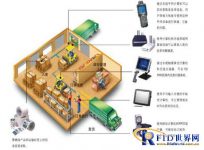
Jiangsu Tangan Passive UHF RFID Warehouse Management System
[ad_1]
I. Overview
The RFID warehouse management system is a platform for cargo identification, tracking, management and inspection of cargo information based on RFID identification technology. The system combines RFID identification technology with computer database management and query to automatically identify cargo information. The application of this system can greatly save Human and material resources, convenient management, improved efficiency and accuracy, and convenient data statistics.

2. Limitations of traditional warehouse management systems
1. Traditional warehousing uses manual methods. The recording method is cumbersome, inefficient, error-prone, and the cost is relatively high, which is particularly inconvenient for statistics and management
2. It is not convenient to receive the goods if the order is not standardized
3. The semi-automated warehouse management system needs to record and enter the computer before entering and exiting the warehouse. The human factor is relatively large, the accuracy is not high, and the forged data is prone to appear
4. The requirements for standardized operation of personnel are relatively high, human resources are wasted, and management and maintenance costs are relatively high
5. Both methods require the storage of goods to be very standardized, and regular inventory needs to be carried out, which is not convenient
6. Inability to provide managers with real-time, fast and accurate inventory information in order to implement the most reasonable decisions, and may lose customers because of this
Three, UHF frequency band application advantages
1. UHF frequency band has the advantages of wide frequency range, fast reading speed, large number of identifications, etc.
2. Passiveelectronic labelMaintenance-free, has the characteristics of long service life, can be reused to save enterprise investment costs
3. It has a good anti-collision function for multiple labels
Four, system principle
4.1 System composition
The system is mainly composed of “warehouse management system software”, “monitoring computer”, “RFID reader” and “RFID electronic tag”
Install
Distribute “RFID electronic tags” for storage items and load-bearing pallets that need to be managed to form a one-card-one-object binding relationship
Install “RFID e-readers” at the entrances and exits to collect data on the entry and exit of items carrying RFID tags
4.2 Working principle
When the pallets and items with RFID tags enter the recognition range of the reader, the reader reads and decodes the pallet tag information, and then sends the data to the central information system via TCP/IP.

4.3 System function architecture diagram

4.4 System business flowchart

Five, system function
1. Equipment management (RFID reader and tag management)
2. Regional management (RFIDReader and area binding, area permission configuration)
3. Goods management (items in and out of warehouse, inventory, destruction management)
4. Approval process management
5. Abnormal alarm (items are not arranged out of the warehouse, quantity alarm)
6. Personnel authority management
7. Failure detection (reader failure)
Six, system advantages
1. Efficiently complete various business operations, improve warehouse management, and increase efficiency and value
2. Fully automatic identification of items in the warehouse without human intervention, and multiple items can be identified at the same time to improve accuracy and efficiency
3. Fast, accurate, automatic data collection, real-time and accurate control of inventory
4. Reduce the inventory cycle, improve the real-time performance of data, grasp the inventory situation dynamically in real time, and realize the visual management of inventory items
5. Observe the working conditions of the staff in the warehouse in real time and grasp the work progress
6. Safely manage inventory to prevent illegal acts such as theft and vandalism
7. Reduce manpower and management costs
Seven, product introduction
7.1 Hardware products
1. ETAG-R520 902~928MHz UHF Split RFID Reader

|
working frequency:
|
902~928MHz
|
|
Polarization mode:
|
Circular polarization
|
|
Antenna gain:
|
8 dBi
|
|
Voltage standing wave ratio:
|
≤1.4
|
|
Front-to-back ratio:
|
≥20 dB
|
|
Half power angle:
|
Hor: 63°, Ver: 56°
|
|
power:
|
10 W
|
|
impedance:
|
50 Ω
|
|
Connector:
|
N-female
|
|
Lightning protection:
|
DC grounding
|
|
Effective wind area:
|
≤0.2 m²
|
|
Maximum wind resistance:
|
60m/s
|
|
Radiation material:
|
aluminum
|
|
Radome material:
|
ABS(White)
|
|
size:
|
260 * 260 * 45mm
|
|
weight:
|
1.2kg
|
|
Operating temperature:
|
-10~+60°C
|
|
stored temperature:
|
-25~+80°C
|
|
Relative humidity:
|
5%~95%(No condensation)
|
3. ETAG-T521 902~928 UHF RFID Pallet Tag

|
working frequency:
|
902~928MHz
|
|
supporting agreement:
|
ISO18000-6C
|
|
Chip type:
|
H3
|
|
Reading and writing category:
|
Can read and write(512bit)
|
|
effective distance:
|
5~10m
|
|
Size:
|
86*54*0.4mm
|
|
Packaging materials:
|
Coated paper orPET
|
|
Operating temperature:
|
-20~+65°C
|
|
stored temperature:
|
-30~+85°C
|
|
Relative humidity:
|
5%~95%(No condensation)
|
|
Installation method:
|
Adhesive
|
[ad_2]



